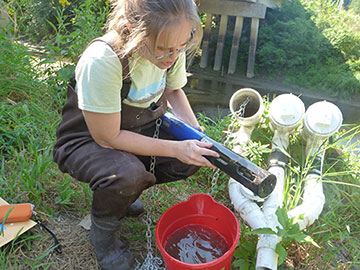Climate and Water Quality Dynamics in Agro-Ecosystems
In eastern Iowa, agriculture is the predominant land use, with upwards of 90% of the land surface dedicated to production. Multiple ongoing studies at the University of Iowa are focused on the interaction of the agricultural system with climate dynamics to produce both water quality and quantity responses. 
One project, funded by the Iowa NSF EPSCoR: Harnessing Renewable Energy, has deployed a network of three EXO2 sondes at their Clear Creek Bioenergy Agro-Ecosystem Research site to monitor water quality and quantity responses.
This equipment is part of a larger network designed to quantify balances in water, carbon, nitrogen, and energy at the scale of catchments.
This work will support numerical simulations that consider climate variability, human decision-making, and water quality and quantity responses for different biomass production strategies, including alternative energy crops. The EXO instruments are deployed at three nested sites on first-, second-, and third-order streams in a predominantly agricultural basin. The sensors provide fDOM, turbidity, specific conductivity, temperature, pH, ORP, ammonium, and dissolved oxygen data every 15-minutes at each site.
“These sondes provide a single platform that supports our study of water, carbon, nitrogen, energy, and sediment balances,” says Adam Ward, an Assistant Professor at the University of Iowa.
“These allow us to collect high temporal resolution on each of these interacting systems during storm dynamics – we could never collect nor process enough grab samples to rival the richness in the time-series data provided by these sondes.”
“We are living in a landscape where human decisions and environmental outcomes are intimately linked,” continues Ward. “The data we are collecting helps us learn about the current configuration of the system. We will also use these data for model calibration and validation, enabling us to explore a host of potential future scenarios with interacting climate, land management, and environmental outcomes.”
The EXO2 sondes are part of a monitoring network that has also been used to study catchment water quality and quantity responses to storm events (National Science Foundation Grant DEB-1263559), and supports the Intensively Managed Landscapes Critical Zone Observatory, recommended for funding by the NSF in 2013. The Iowa NSF EPSCoR project is supported by the National Science Foundation as Grant Number EPS-1101284.
Any opinions or endorsements here reflect the opinion of the author and are not an endorsement by the National Science Foundation. A special thanks to our guest blogger, Adam Ward, Assistant Professor at the University of Iowa, for contributing the information for this post.

Additional Blog Posts of Interest:
Trouble Collecting Data with Your Water Quality Sonde? Try This!
Get the Most from Your Water Quality Sonde - Webinar
Real-Time Water Quality Monitors Gauge Florida Lagoon's Health
How Does Real-Time Data Save You Time?